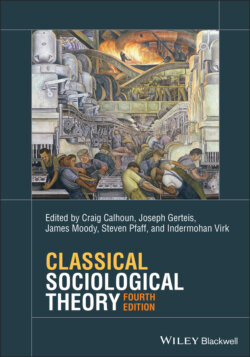Читать книгу Classical Sociological Theory - Группа авторов - Страница 57
Jane Addams
ОглавлениеJane Addams was born in 1860 to a middle-class family in Cedarville Illinois. Her father was a successful mill owner and local politician. Her mother died when she was two and Addams was close to her father, who wanted a good higher education for all his children. He sent Addams to Rockford Seminary where she graduated valedictorian of the class. Like many newly-educated women of the time, professional use of her education was limited and Addams felt this constraint deeply. She started medical school but health issues pushed that off, and had a nearly ten-year period of aimlessness searching for an outlet for her energy and intellect. During this time, she visited a London settlement house (social welfare agency) which sparked the idea of founding a similar institution back home. Along with Hellen Gates Starr, Addams co-founded Hull House in the new industrial metropolis of Chicago.
In many ways, Hull House became the practical muse behind much of Addams work and worldview. The settlement house movement aimed to provide a place for immigrants and the poor to work and live. The philosophy was one of embedded self-help: not providing services for others but working directly with them to build a vibrant community. Hull House was this and more – becoming a laboratory for many innovative social programs and projects, ranging from playgrounds for kids to a dedicated juvenile court. Hull House was co-educational and included projects and opportunities for men and women, but it was clearly women centered with a focus on “foregrounding women’s experiences, analysis and concerns.” (see Hamington 2019). Living and working in Hull House made clear to Addams the stark misfortunes and difficulties of poverty, racism, and sexism in America. Addams’ understanding of social institutions, programs and activism built directly from the experiences of the people living and working in Hull House.
The success of Hull House propelled Addams into the role of a popular public activist. She wrote numerous essays, visited politicians, and otherwise directly advocated for the needs of the poor and oppressed. She was active in founding the National Association for the Advancement of Colored People (NAACP) and the American Civil Liberties Union (ACLU). She was active in the Progressive Party and co-nominated Theodore Roosevelt. She was also a committed pacifist, which brought her considerable criticism once America entered World War I, though her steadfast support for nonviolence was ultimately recognized with a Nobel Peace Prize in 1931.
Her grounded approach to finding solutions to everyday problems based on the lived experiences of those in need was complemented theoretically by her foundation in pragmatism and interactionist theory. She was a contemporary and collaborator with both John Dewey and George Herbert Mead and much of her work builds from these points of view. Pragmatism is a branch of philosophy founded in American that takes an embedded point of view on philosophical questions: what matters is not building rational or theoretical systems, but rather testing ideas against real situations in the world. John Dewey is a foundational thinker in this tradition. Dewey visited Hull House and had long-standing correspondence and interactions with Addams and their work built on each other’s projects and ideas. Addams had a close relationship with Mead and his wife, both parties frequently visiting each other and lecturing together. In 1916, Mead supported the University of Chicago giving Addams an honorary doctorate, though it was only conferred after her 1931 Nobel Prize. The notion of building insights from close observation of situations shows a clear linkage in their intellectual styles.
Addams realized that the great modern transformations linked to democracy and the market had left many behind. Liberalism with its focus on commerce, industry and civic life overlooked the world of women, particularly regarding household labor and the enduring burden of patriarchy that they endured. The theory we excerpt here is from “A Belated Industry” an article published in AJS in 1896. The work addresses liberalism’s exclusions and nicely illustrates the mix of close examination of a particular life-situation (female domestic labor) and concerns with equality. In the piece, Addams notes that domestic labor has been left behind much of (then) contemporary working life in that domestic workers are isolated from each other and fully dependent on employers. This lack of fellow-interaction undercuts their ability to recognize their situation and, thus, to assemble any power or resources for building equity and justice. The kind of civic action that Tocqueville identified as making democracy work by integrating the members of society had simply excluded most working women.
Addams’ work reveals the critical strain in the liberal tradition that revealed how the bald logic of the market threatens unchecked exploitation and social isolation. By the start of the 20th century, liberal thinkers were increasingly worried that the logic of the market was driving social disintegration in ways that voluntary associations and political reform could not arrest.
